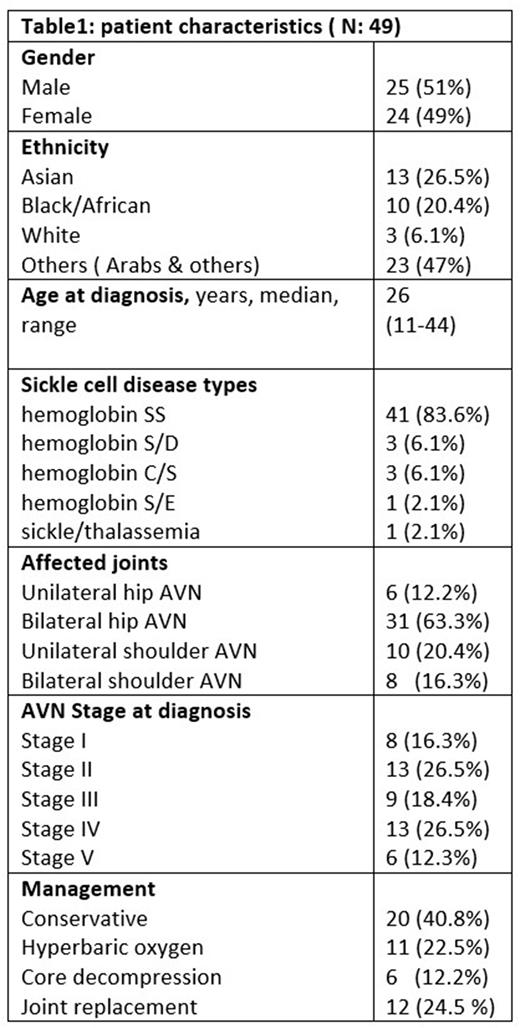Abstract
Background:
Vascular necrosis (AVN) is a well-described debilitating complication in sickle cell disease (SCD) patients, and the management is usually challenging. Data about the clinical presentation, risk factors, radiological features, and management options are lacking. This study aims to evaluate the clinical and epidemiological features and therapeutic options of avascular necrosis in sickle cell patients in Qatar.
Patients and methods:
A cross-sectional study was conducted on a group of 49 sickle cell disease patients who are suffering from avascular necrosis and attending a hematology clinic at the National Center for Cancer care & research hospital (NCCCR), Hamad Medical Corporation (HMC), Qatar between Jan-2011 to Jan2021. Clinical presentation, age at first AVN diagnosis, hemoglobin S level, affected joints, hydroxyurea treatment and compliance, and stage at diagnosis were recorded. Management options included conservative physiotherapy, hyperbaric oxygen, core decompression, and hip replacement.
Results:
Forty-nine adult patients with sickle cell disease complicated by avascular necrosis were reviewed. The median age of the study population is 32 years (range: 18-64) and the median age of AVN diagnosis is 26 years (range: 11-44). 25 patients (51 %) were males. 41 patients (83.6%) had hemoglobin SS, 3 (6.1%) with hemoglobin S/D (double Heterozygosity), 3 (6.1%) hemoglobin C/S, 1 (2.1%) with hemoglobin S/E, and 1 (2.1%) with sickle/thalassemia. 37 (75.5%) patients suffered from multiple joints AVN while 12(24.5%) had single joint involvement. 31 (63.3%) patients had bilateral hip AVN and 18 (36.7%) had shoulder involvement. The majority of the patients (79%) were symptomatic where joint pain and a limited range of motion were the most common symptoms. 30 patients (61%) of the recruited population were on Hydroxyurea; six of them (20%) were non-compliant.
Based on FICAT and Alert classification of AVN, 8 (16.3%) patients had stage I, 13(26.5%) had stage II, 9 (18.4%) had stage III and 13 (26.5%)patients were at stage IV; 6(12.3%) patients were at stage V. 57 % of patients had stage III and above at diagnosis. 20 (40.8%) were managed with a conservative approach with physiotherapy only, 11 (22.4%) received hyperbaric oxygen with good response, 6(12.2%) underwent hip core decompression and 12(24.5%) underwent a hip replacement.
Conclusion:
The majority of AVN patients had an advanced stage and multiple joint involvements at diagnosis. We suggest a low threshold of joint imaging for early detection and prevention of further complications. Hyperbaric oxygen, if implemented early, might be a possible option to avoid or delay surgical intervention.
Disclosures
No relevant conflicts of interest to declare.
Author notes
Asterisk with author names denotes non-ASH members.


This feature is available to Subscribers Only
Sign In or Create an Account Close Modal